Analysis of textbook outcomes for ampullary carcinoma patients following pancreaticoduodenectomy
Xiao-Jie Zhang,He Fei,Chun-Guang Guo,Chong-Yuan Sun,Ze-Feng Li,Zheng Li,Ying-Tai Chen,Xu Che,Dong-Bing Zhao
Abstract BACKGROUND Textbook outcomes (TOs) have been used to assess the quality of surgical treatment for many digestive tumours but not ampullary carcinoma (AC).AIM To discuss the factors associated with achieving a TO and further explore the prognostic value of a TO for AC patients undergoing curative pancreaticoduodenectomy (PD).METHODS Patients who underwent PD at the China National Cancer Center between 1998 and 2020 were identified.A TO was defined by R0 resection,examination of ≥ 12 Lymph nodes,no prolonged hospitalization,no intensive care unit treatment,no postoperative complications,and no 30-day readmission or mortality.Cox regression analysis was used to identify the prognostic value of a TO for overall survival (OS) and recurrence-free survival (RFS).Logistic regression was used to identify predictors of a TO.The rate of a TO and of each indicator were compared in patients who underwent surgery before and after 2010.RESULTS Ultimately,only 24.3% of 272 AC patients achieved a TO.A TO was independently associated with improved OS [hazard ratio (HR): 0.443,95% confidence interval (95%CI): 0.276-0.711,P=0.001] and RFS (HR: 0.379,95%CI: 0.228-0.629,P < 0.001) in the Cox regression analysis.Factors independently associated with a TO included a year of surgery between 2010 and 2020 (OR: 4.549,95%CI: 2.064-10.028,P < 0.001)and N1 stage disease (OR: 2.251,95%CI: 1.023-4.954,P=0.044).In addition,the TO rate was significantly higher in patients who underwent surgery after 2010 (P < 0.001) than in those who underwent surgery before 2010.CONCLUSION Only approximately a quarter (24.3%) of AC patients achieved a TO following PD.A TO was independently related to favourable oncological outcomes in AC and should be considered as an outcome measure for the quality of surgery.Further multicentre research is warranted to better elucidate its impact.
Key Words: Ampullary carcinoma;Textbook outcomes;Pancreaticoduodenectomy;Prognosis
INTRODUCTION
Ampullary carcinoma (AC) is a rare tumour constituting only 0.6%-0.8% of all digestive system malignancies[1],and the incidence of AC has increased over the last 2 decades[2].Pancreaticoduodenectomy (PD) is one of the standard treatment strategies for curative purposes.The prognosis of AC patients is better than that of patients with other peri ACs[3],with a nearly 50% resection rate[4].Surgery has improved substantially with advances in surgical techniques;however,there is still a lack an effective measure to evaluate the quality of surgery.Sunet al[5] found inflammatory index can be regarded as a more useful prognostic index and Gonzalezet al[3] established a nomogram to predict disease-specific survival;however,these method did not have intuitive indicators.Recently,textbook outcomes (TOs) have emerged and been applied in evaluating treatments for many tumours.To our knowledge,no previous study has explored the clinical value of a TO in AC patients.
The concept of the TO was first proposed by Kolfschotenet al[6] to investigate hospital variation in the Netherlands as a composite quality metric that encompassed several indicators of quality.Generally,individual quality metrics such as mortality and complications are applied to evaluate the quality of surgery[7,8];however,these single indicators may lack practicality in reflecting the overall prognosis.As a composite metric,the TO represents the strength of all indicators based on important short-term outcomes and is thus more reliable and comprehensive than a single outcome measure[9,10].Since the concept of the TO emerged in surgery for colon cancer,it has been defined for the treatment of many other tumours,such as gastroesophageal cancer and intrahepatic cholangiocarcinoma[9,11].The definition of a TO follows the all-or-none principle[12] because partially favourable outcomes are not perfect postoperative outcomes.
Previous studies have successfully proven that a TO is associated with improved long-term survival in pancreatic adenocarcinoma patients who undergo PD[13-15],as well as for patients in other surgical fields[6,16,17].Milbank considered PD to require a broad judgement to monitor and compare the quality of procedures[18].Based on the above situation,the aims of this study were to propose a TO definition for AC patients and characterize the impact of a TO on survival.In addition,we assessed the factors associated with achieving a TO.
MATERIALS AND METHODS
Data source and study population
Patients who underwent surgery for AC between 1998 and 2020 in the China National Cancer Center were selected for analysis.Inclusion criteria: (1) Pathologically proved as AC;and (2) Patients were submitted to radical surgery.Patients with missing data necessary to define TO were excluded: R0 resection (n=4),lymph nodes examined (n=9),hospitalization (n=8) intensive care unit (ICU) treatment (n=6),postoperative complications (n=10),tumor differentiation (n=4).A total of 41 patients were excluded from analysis and 272 AC patients were included.
TO
TO represents optimal oncologic care after PD for AC as a single composite measure.TO was achieved if the following indicators are fulfilled: The surgical margin was negative (R0 resection),≥ 12 Lymph nodes examined (American Joint Committee on Cancer,eighth edition)[19],no prolonged hospitalization (< 75thpercentile)[6,20],no ICU treatment,no postoperative complications,no 30-day readmission or mortality[13],hospitalization was defined as day of operation to day of discharge.
Statistical analysis
we counted the number of patients each of the indicator and calculated the cumulative proportion.The collected data was presented as frequencies and proportions,and was compared between the groups with and without TO using the Chisquare test.Cox regression analysis was used to identify if TO was an independent prognostic factor for overall survival(OS) and recurrence-free survival (RFS).Multivariable logistic regression was performed to determine the relationship between baseline characteristics and TO,factors withP< 0.2 in univariate analysis were included in the multivariate analysis,and odds ratios (OR) or hazard ratios (HR) and their 95% confidence intervals (95%CI) were reported.Survival curves of OS and RFS were plotted using the Kaplan-Meier method to determine the effect of TO on survival.We divided the patients into two groups by the year of surgery before and after 2010 to see the TO rate trend.
Follow-up was mainly conducted by telephone and though outpatient rechecks,other information was obtained by medical records and population death register information system.All data were analyzed with SPSS software (version 21;SPSS Inc.,Chicago,IL,United States).Kaplan-Meier survival analyses were performed in R software (Version 3.5.1;R Foundation for Statistical Computing,Vienna,Austria).Pvalue < 0.05 was considered statistically significant.
RESULTS
TO and survival
A total of 272 AC patients met the inclusion criteria.A TO was observed in 66 (24.3%) patients.Among the indicators used to define a TO,R0 resection (99.6%),no 30-day readmission or mortality (93.0%) and no ICU treatment (90.1%) were achieved easily,while Examination of ≥ 12 Lymph nodes (58.5%) and no postoperative complications (48.9%) were not achieved as easily.The data for the 6 TO indicators and the cumulative proportions are shown in Figure 1.

Figure 1 Textbook Outcome percentages (parameter and cumulative) after pancreatoduodenectomy.
Cohort characteristics
Patients were divided into a TO group (66 patients,24.3%) and a non-TO group (206 patients,75.7%).There were significant differences in the year of surgery,N stage,TNM stage and lymphovascular invasion (P< 0.05) between the two groups and no significant differences in sex,age,operation time,blood transfusion,tumour size,differentiation,CA199,T stage or adjuvant treatment (P> 0.05).Baseline characteristics for the TO and non-TO groups are presented in Table 1.
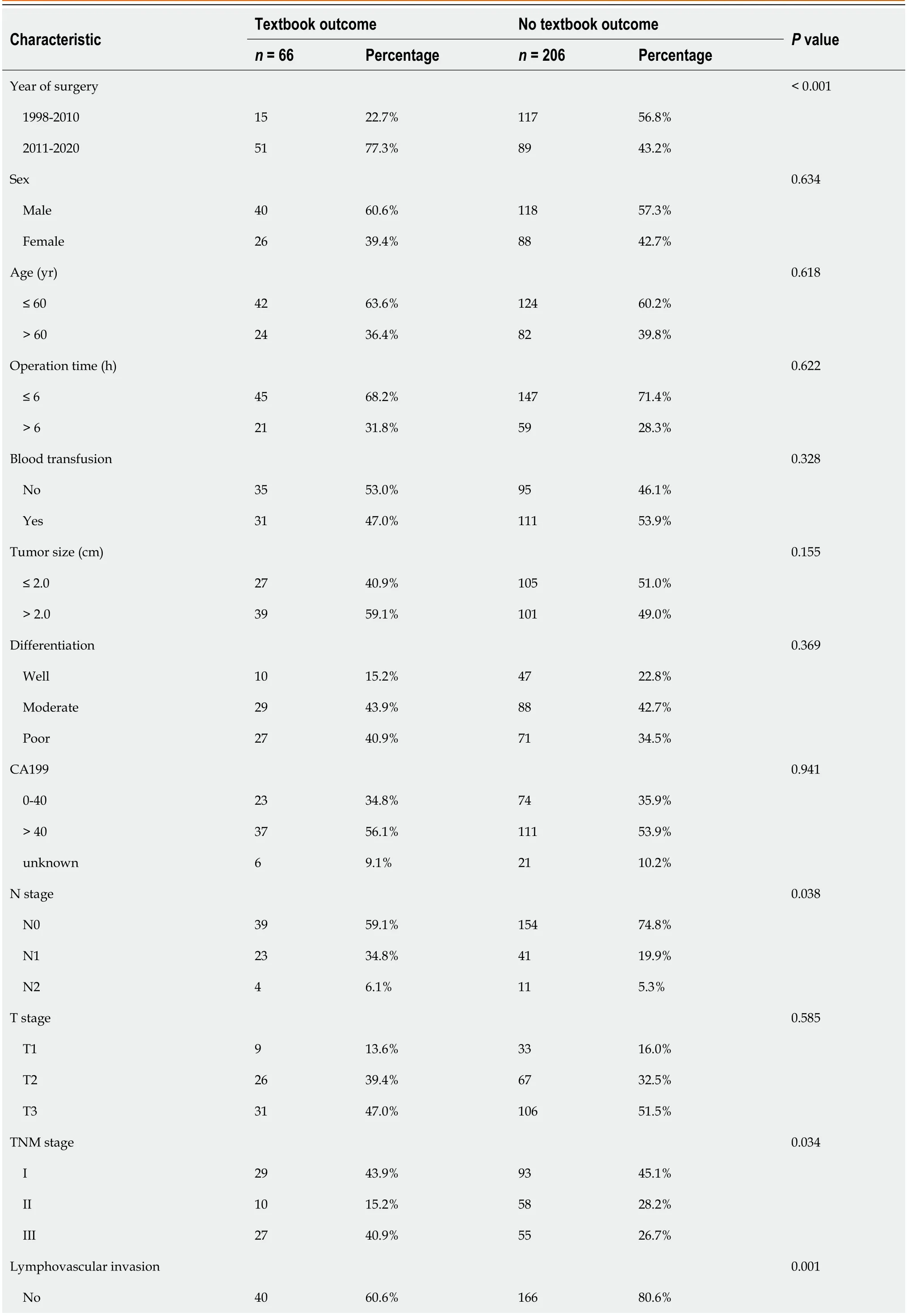
Table 1 Baseline characteristics for patients with or without a Textbook Outcome after pancreatoduodenectomy
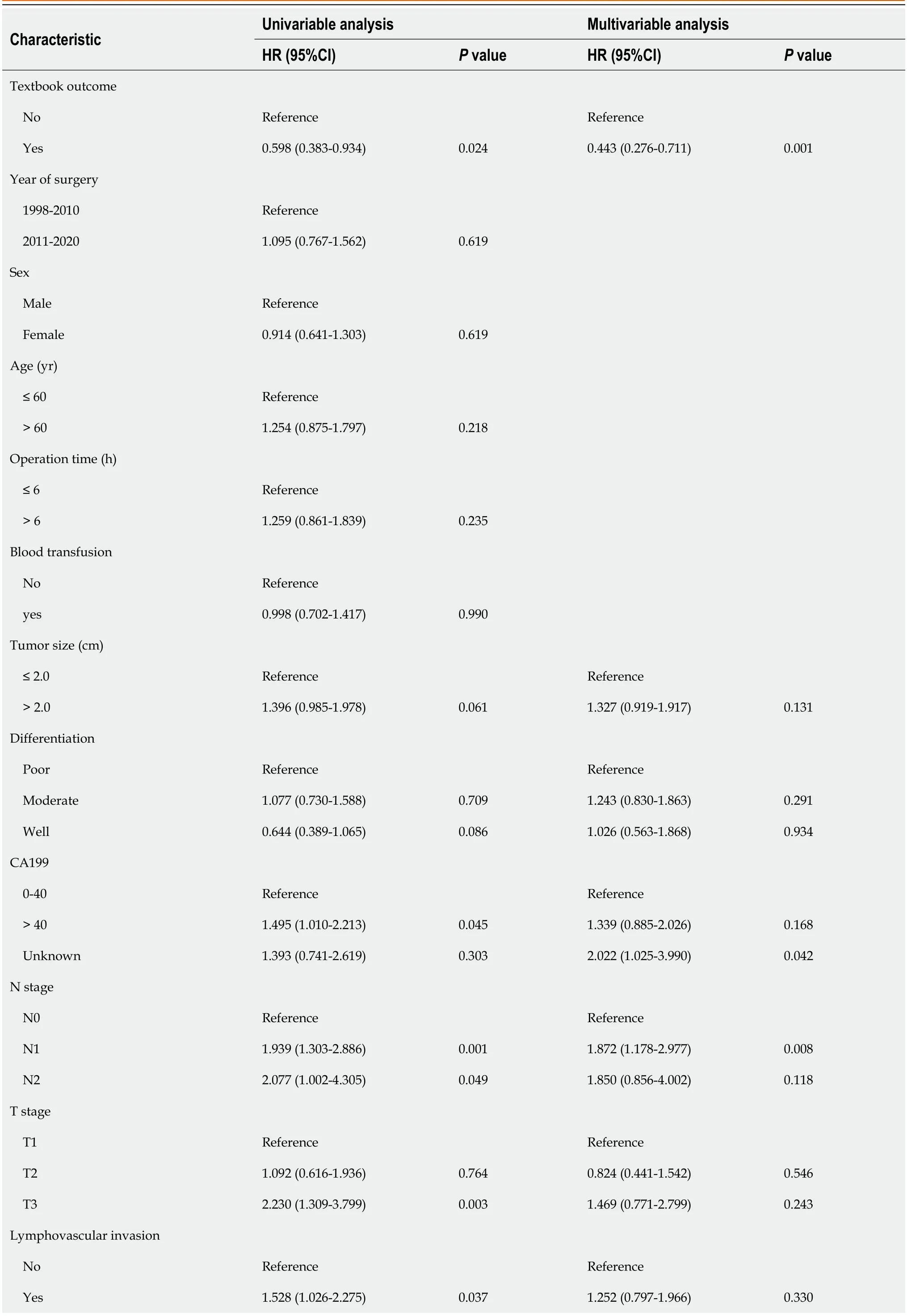
Table 2 Univariable and multivariable Cox regression analyses of clinicopathological factors for overall survival
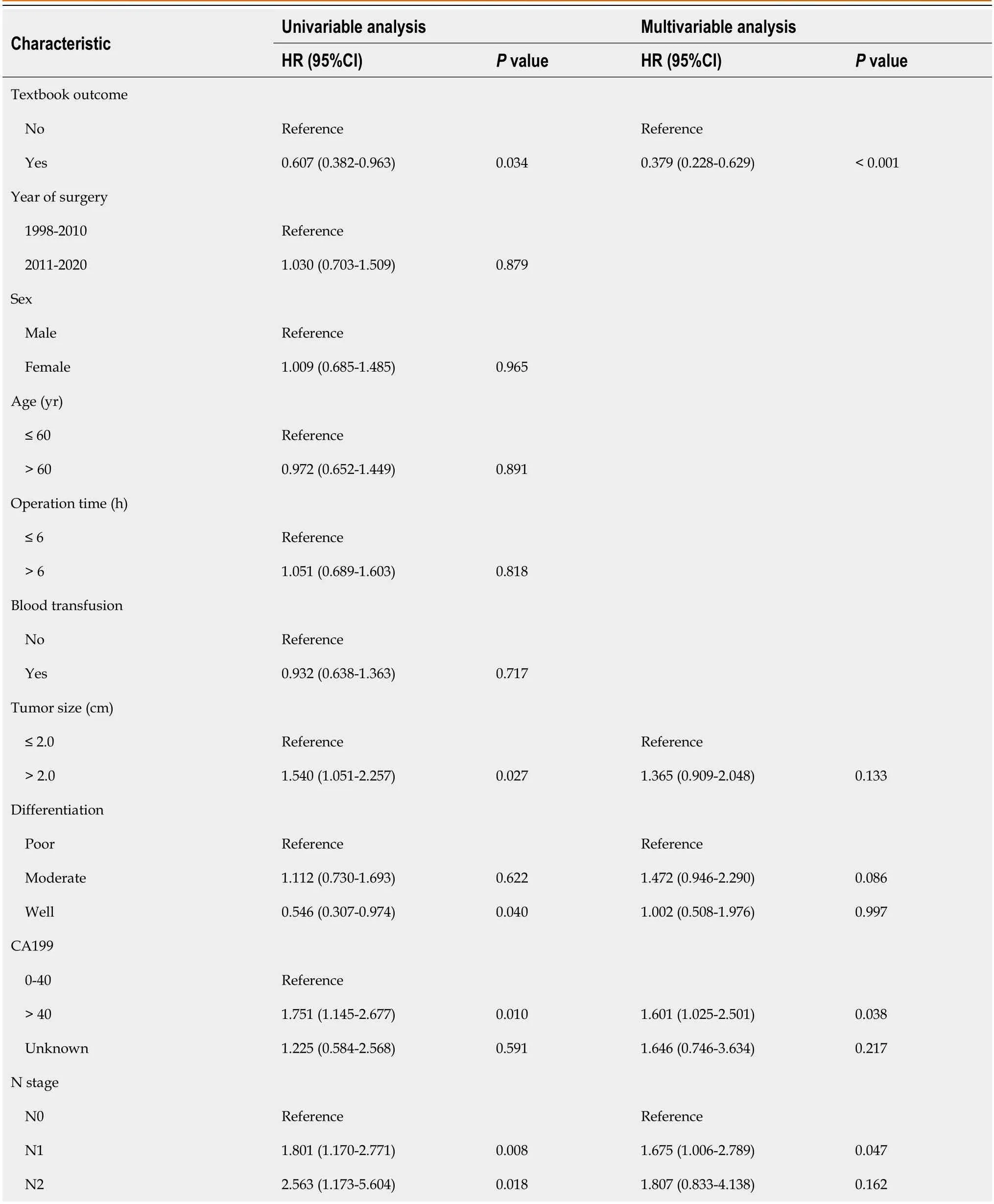
Table 3 Univariable and multivariable Cox regression analyses of clinicopathological factors for recurrence free survival
Survival analysis
On Kaplan-Meier survival analysis,a TO was associated with better OS and RFS (allP< 0.05) in AC (Figure 2).The median survival and median recurrence-free survival in the non-TO group were 48 and 42 mo,respectively,whereas the median survival was not reached in the TO group.The Kaplan-Meier survival curve is shown in Figure 2.
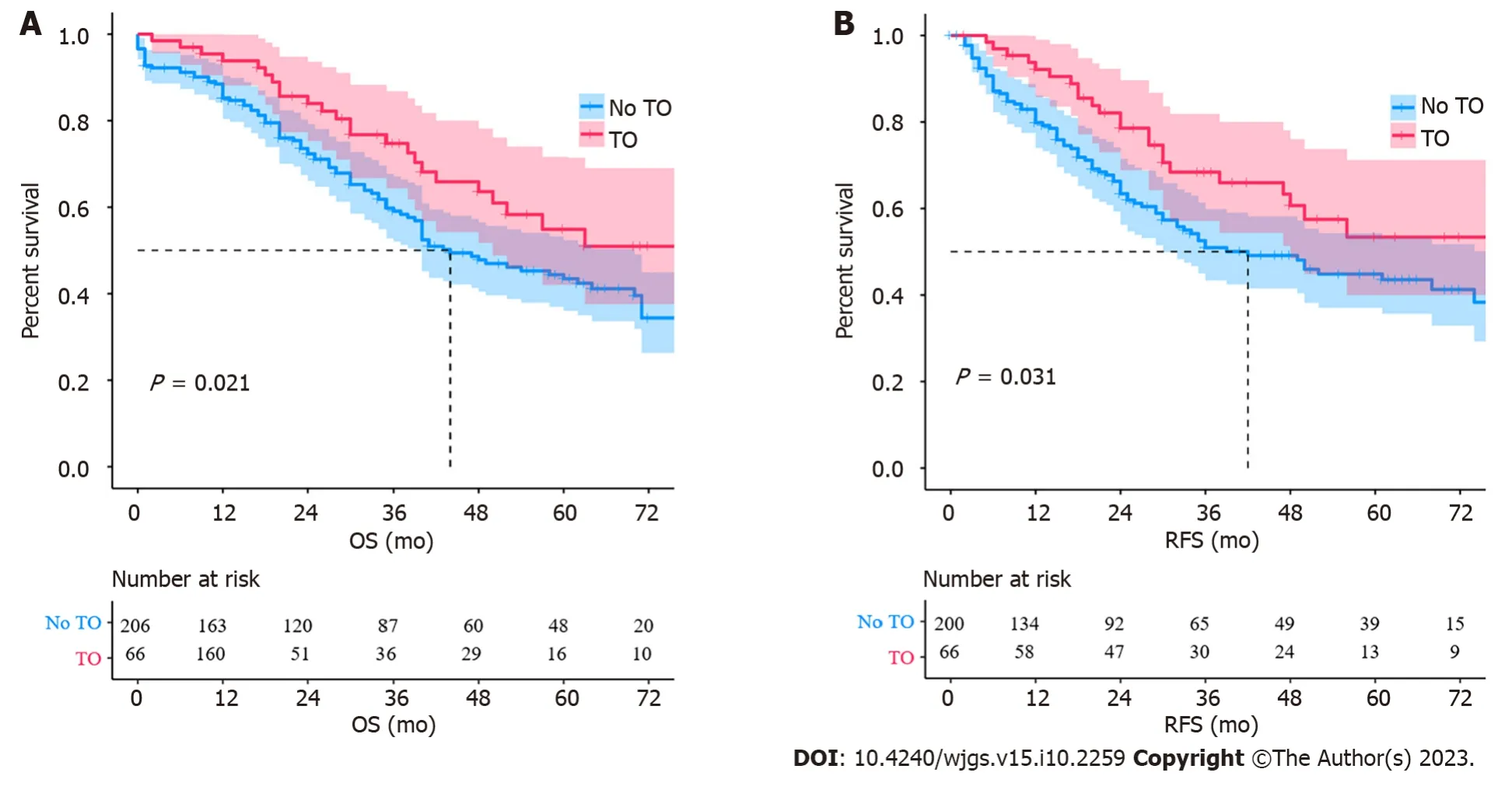
Figure 2 The Kaplan-Meier survival curves stratified by achievement of textbook outcome for ampullary carcinoma patients after pancreaticoduodenectomy. A: Overall survival curve;B: Recurrence free survival curve.ICU: Intensive care unit;OS: Overall survival;RFS: Recurrence free survival;TO: Textbook outcomes.
Cox regression analysis showed that a TO was related to improved OS (HR: 0.443,95%CI: 0.276-0.711,P=0.001) and RFS (HR: 0.379,95%CI: 0.228-0.629,P< 0.001) and that N1 stage disease (HR: 1.872,95%CI: 1.178-2.977,P=0.008) was an independent risk factor for OS.Regarding RFS,preoperative CA 199 Level > 40 (HR: 1.601,95%CI: 1.025-2.501,P=0.038),N1 stage disease (HR: 1.675,95%CI: 1.006-2.789,P=0.047) and lymphovascular invasion (HR: 1.892,95%CI: 1.161-3.081,P=0.010) were all independent risk factors.The detailed data are depicted in Tables 2 and 3.
TO-associated factors
Logistic regression revealed that a year of surgery between 2010 and 2020 (OR: 4.549,95%CI: 2.064-10.028,P< 0.001) and N1 stage disease (HR: 2.251,95%CI: 1.023-4.954,P=0.044) were independently associated with lower odds of a TO.The results of the univariable and multivariable logistic regression analyses are shown in Table 4.
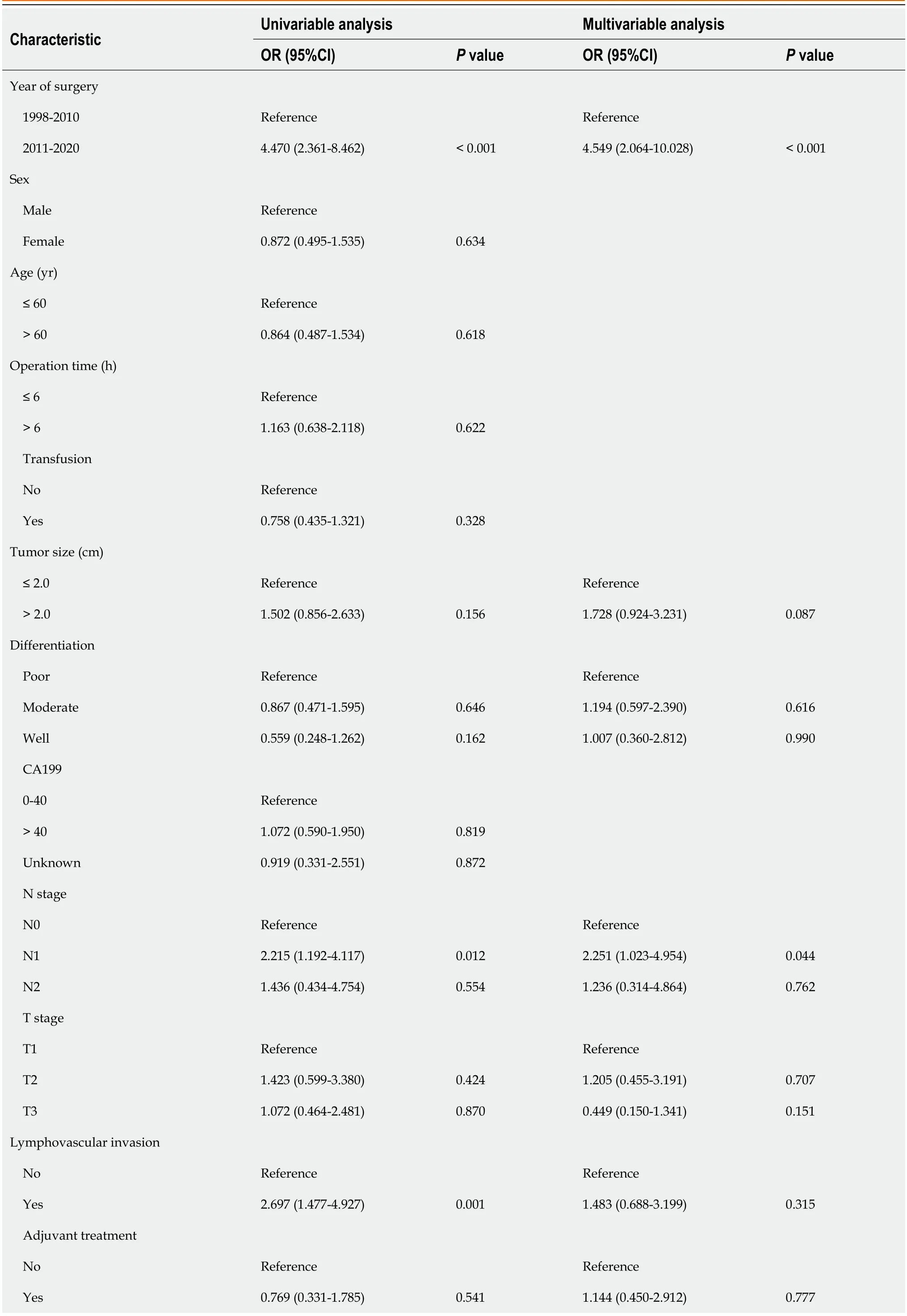
Table 4 Univariable and multivariable logistic regression analyses of factors associated with textbook outcome
Time-related trends
Fifteen (132,11.4%) patients treated before 2010 and 52 (140,36.4%) patients treated after 2010 achieved a TO.The TO rate significantly increased after 2010 (P< 0.001),mainly due to improvements in lymphadenectomy (P< 0.001) and 30-day readmission or mortality (P=0.030).The detailed data are depicted in Table 5.

Table 5 Trends over years for individual textbook outcome parameters after controlling clinicopathological factors by logistic regression analyses
DlSCUSSlON
TOs are composite measures that represent ideal outcomes and have been used to assess the quality of surgical treatment for many digestive tumours.To our knowledge,this is the first study to define and examine a TO in the evaluation ofoutcomes in AC patients undergoing PD.We performed a hospital-based retrospective study of 272 patients undergoing curative surgery and found that only 24.3% achieved a TO.In addition,we found that a TO was independently associated with improved OS and RFS.The current study is important because it is the first to demonstrate that a TO is a potentially significant composite indicator for evaluating the quality of surgical treatment for AC.
Improving the quality of care remains a topic of interest for patients and physicians.As far back as 20 years ago,the Society for Thoracic Surgeons started a clinical audit to monitor their results[21].Recently,TOs have become increasingly accessible for use in assessing the quality of surgical care as combinations of universal variables[17].Prior studies have typically used isolated parameters to measure quality,such as prolonged hospitalization,morbidity,mortality and readmission[7,22,23].However,the limitations of these individual metrics were gradually revealed with the progression of research,and they cannot reflect the quality of care completely[14,24,25].On the other hand,hospitals might perform well in terms of one indicator and worse in terms of another[6,7].Combining these isolated parameters to build a multidimensional metric might be a more accurate method for measuring quality[26].As such,TOs are more reliable and comprehensive than single outcome measures,and the use of TOs might address different domains of surgical quality[27-29].Of note,the all-or-none principle[12] could more accurately reflect desirable patient outcomes and align with ideal patient experiences.From this perspective,a TO is a much more patient-centred metric.
A TO directly reflects the short-term outcomes of rapid recovery and early discharge.However,assessment of longterm outcomes is equally important.Several studies have examined the relationship between a TO and survival among cancer patients.Kulshresthaet al[30] found that 37.2% of oesophageal cancer patients achieved a TO,which appeared to be associated with improved OS [Ed1].Aquinaet al[31] indicated that achieving a TO was related to better OS in the treatment of all eight kinds of cancer in the National Cancer Database.Consistently,similar results were found for PD in the treatment of pancreatic neuroendocrine tumours[32] and pancreatic adenocarcinoma[13-15,33].Furthermore,we found that achieving a TO was independently associated with improved OS (HR: 0.443,95%CI: 0.276-0.711,P=0.001) and RFS (HR: 0.379,95%CI: 0.228-0.629,P< 0.001).As such,achieving a TO is very significant,and these studies demonstrate the necessity and importance of improving surgical techniques and the quality of clinical care[34,35].To this end,a TO is a reliable and valuable metric and should be applied in more clinical research.
Only approximately a quarter (24.3%) of patients achieved a TO in our research,meaning that adverse events occurred in a sizable fraction of patients.Previous studies on the achievement of a TO have shown large variations,with an average of 49% in colon cancer[6],25.5% in intrahepatic cholangiocarcinoma[8],32.1% in gastric cancer and 29.7% in oesophageal cancer patients[15].Merathet al[36] found that TO rates varied from 11.1% to 69.6% after pancreatic surgery among hospitals.Aquina and associates[31] showed that the TO rate of pancreatic cancer patients was the lowest at 25%among that of all cancer patients.Similarly,only 16.8% of patients achieved a TO in the study by Sweigert and his colleagues[13].In the present study,the achievement of a TO was mainly hampered by examination of ≥ 12 Lymph nodes(58.5%) and no postoperative complications (48.9%).The major hampering indicators in other studies include R0 resection[31],no prolonged hospital stay[36],and receipt of adjuvant chemotherapy within 12 wk[13,15],which showed considerable variation.As mentioned above,the wide variation among different hospitals further supports the superiority of TOs.Factors independently associated with a TO included a year of surgery between 2010 and 2020 (OR: 4.549,95%CI:2.064-10.028,P< 0.001) and N1 stage disease (OR: 2.251,95%CI: 1.023-4.954,P=0.044).Similar results were also found in pancreatic adenocarcinoma patients[13],which was mainly attributed to advancements in surgical techniques and the increasing number of examined lymph nodes.The proportion of AC patients with a TO remained low even at a large medical centre such as ours,which indicates great potential for improvement.Overall,a TO could be applied to guide quality improvement as a reliable metric[31].
Due to the observation of increasing trends in TO rates over the years (P< 0.05),we divided the patients into two groups by the year of surgery before and after 2010 and compared the trends of every indicator over time.Of note,the improvement in the TO rate was mainly attributed to the reduction in postoperative complications and increase in adequate lymphadenectomy,which indicated that there were significant advances in surgical techniques over time.
However,Hyeret al[37] found that the improvement was mainly driven by a decline in mortality and prolonged hospital stay.Perioperative management should be further strengthened to better improve the quality of surgery.
There are several limitations to this study.First,the current study was a retrospective review of data from a large single centre,which might introduce the risk of selection bias.Second,our study had some missing data,such as estimated blood loss and details regarding adjuvant treatment.In addition,only a few patients underwent minimally invasive surgery,a subgroup analysis was not conducted.These factors could limit the generalizability of the study results.Third,no patients with T4 stage disease were included in this study due to the combined effects of the inclusion and exclusion criteria;therefore,the TO rate is possibly lower than described.Fourth,the TO definition was based on previous studies and is still in the early phase of development.Some indicators,such as patient satisfaction,social vulnerability[38] and hospital volume[39],which have been shown to affect the chances of achieving a TO,were not evaluated.There is an urgent need for a standard definition for a TO in AC patients who undergo PD.
CONCLUSION
In conclusion,only approximately a quarter (24.3%) of patients achieved TO in AC patients following PD and achieving TO was independently related to favorable oncological outcomes in AC.This study demonstrated that TO was a simple and reliable composite measure of ideal outcomes following PD which could completely and effectively evaluate the overall quality of surgical care.Further multicenter research is warranted to better elucidate its impact.
ARTICLE HIGHLIGHTS
Research background
Textbook outcome (TO) is a composite measure that represents the ideal outcome and has been used to assess the quality of surgical treatment in many digestive tumors.
Research motivation
Lack of an effective measure to evaluate the quality of surgery for ampullary carcinoma (AC).
Research objectives
This study aimed to investigate the impact of TO on survival for AC patients following pancreaticoduodenectomy and the factors associated with achieving TO.
Research methods
We defined the concept of TO in ampullary carcinoma and cox regression analysis was used to identify if TO was an independent prognostic factor for overall survival and recurrence free survival.
Research results
Only approximately a quarter (24.3%) of patients achieved TO and TO was independently related to favorable oncological outcomes in AC.
Research conclusions
TO was a simple and reliable composite measure of ideal outcomes following pancreaticoduodenectomy.
Research perspectives
Further multicenter research is warranted to better elucidate the impact of TO.
FOOTNOTES
Author contributions:Zhang XJ,Fei H and Guo CG contributed equally to this work;Chen YT,Che X and Zhao DB designed the research study,they are the corresponding authors of this paper;Fei H and Zhang XJ analyzed the data;Sun CY,Li Z and Li ZF collected the data;All author wrote the manuscript;All authors have read and approve the final manuscript.
Institutional review board statement:Ethical review and approval were not required for this study in accordance with the National Cancer Center/National Clinical Research Center for Cancer/Cancer Hospital,Chinese Academy of Medical Sciences and Peking Union Medical College.
Informed consent statement:Patients were not required to give informed consent to the study because the analysis used anonymous data that were obtained after each patient agreed to treatment by written consent.
Conflict-of-interest statement:None of the authors have conflicts of interest related to the manuscript.
Data sharing statement:No additional data are available.
Open-Access:This article is an open-access article that was selected by an in-house editor and fully peer-reviewed by external reviewers.It is distributed in accordance with the Creative Commons Attribution NonCommercial (CC BY-NC 4.0) license,which permits others to distribute,remix,adapt,build upon this work non-commercially,and license their derivative works on different terms,provided the original work is properly cited and the use is non-commercial.See: https://creativecommons.org/Licenses/by-nc/4.0/
Country/Territory of origin:China
ORCID number:Xiao-Jie Zhang 0000-0001-9850-9806;He Fei 0000-0003-4831-4028;Chun-Guang Guo 0000-0002-2674-6586;Chong-Yuan Sun 0000-0003-1354-2063;Ze-Feng Li 0000-0002-5345-3527;Zheng Li 0000-0003-4415-6552;Ying-Tai Chen 0000-0003-4980-6315;Xu Che 0000-0002-1634-4524;Dong-Bing Zhao 0000-0002-6770-2694.
S-Editor:Lin C
L-Editor:A
P-Editor:Yu HG
 World Journal of Gastrointestinal Surgery2023年10期
World Journal of Gastrointestinal Surgery2023年10期
- World Journal of Gastrointestinal Surgery的其它文章
- Gastric adenosquamous carcinoma with an elevated serum level of alpha-fetoprotein: A case report
- Giant dedifferentiated liposarcoma of the gastrocolic ligament: A case report
- Hereditary hemorrhagic telangiectasia involving portal venous system: A case report and review of the literature
- Mucocutaneous ulcer positive for Epstein-Barr virus,misdiagnosed as a small bowel adenocarcinoma: A case report
- Three-dimensional computed tomography reconstruction diagnosed digestive tract perforation and acute peritonitis caused by Monopterus albus: A case report
- Postpolypectomy syndrome without abdominal pain led to sepsis/septic shock and gastrointestinal bleeding: A case report
